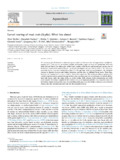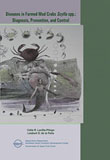Perlihatkan publikasi sederhana
Molecular genetic approaches to resolve taxonomical ambiguity of mud crab species (Genus Scylla) in Indian waters
| dc.contributor.author | Mandal, Anup | |
| dc.contributor.author | Varkey, Mathews | |
| dc.contributor.author | Sobhanan, Sobha P. | |
| dc.contributor.author | Mani, Anjali K. | |
| dc.contributor.author | Thampi Sam Raj, Yohannan C. | |
| dc.contributor.editor | Quinitio, Emilia T. | |
| dc.contributor.editor | Estepa, Fe Dolores P. | |
| dc.contributor.editor | Thampi Sam Raj, Yohannan C. | |
| dc.contributor.editor | Mandal, Anup | |
| dc.date.accessioned | 2017-09-04T10:09:13Z | |
| dc.date.accessioned | 2017-09-04T10:40:50Z | |
| dc.date.accessioned | 2017-09-05T08:47:23Z | |
| dc.date.available | 2017-09-04T10:09:13Z | |
| dc.date.available | 2017-09-04T10:40:50Z | |
| dc.date.available | 2017-09-05T08:47:23Z | |
| dc.date.issued | 2015 | |
| dc.identifier.citation | Mandal, A., Varkey, M., Sobhanan, S. P., Mani, A. K., & Thampi Sam Raj, Y. C. (2015). Molecular genetic approaches to resolve taxonomical ambiguity of mud crab species (Genus Scylla) in Indian waters. In E. T. Quinitio, F. D. Parado-Estepa, Y. C. Thampi Sam Raj, & A. Mandal (Eds.), Proceedings of the International Seminar-Workshop on Mud Crab Aquaculture and Fisheries Management, 10-12 April 2013, Tamil Nadu, India (pp. 45-58). Tamil Nadu, India: Rajiv Gandhi Centre for Aquaculture (MPEDA). | en |
| dc.identifier.isbn | 9788192989815 | |
| dc.identifier.uri | http://hdl.handle.net/10862/3209 | |
| dc.description.abstract | Mud crab or mangrove crab (Genus Scylla de Haan) is one of the most extensively cultured and economically important brachyuran crabs from the family Portunidae in Indo-Pacific countries, including India. Mud crabs exhibit variations in colour, size, spination, polygonal pattern and habitat. These contribute to the confusion in their identification. Accurate identification of the species is essential in the breeding programmes of domesticated stocks and is a crucial factor in the success of stock enhancement programmes. The taxonomic uncertainty of the genus Scylla in India is still an issue and several papers are being published using misleading identification. This is the first attempt to resolve the taxonomical ambiguity of mud crabs commonly found in Indian waters using multiple molecular genetic approaches. ITS-1, RAPD, PCRRFLP and mt-DNA sequencing along with traditional morphometric methods were used. Furthermore, a PCR method was developed by which mud crab species in India could be identified rapidly and accurately. The results of gene sequencing along with other molecular markers clearly indicated that the ‘green’ morph of Indian mud crab is S. serrata, while the ‘brown’ one is S. olivacea which was validated using the revised classification of mud crabs by Keenan et al. (1998). The S. serrata commonly mentioned in published literatures from India is S. olivacea and the S. tranquebarica, as believed by many Indian researchers, should be classified as S. serrata. Therefore, caution should be taken while interpreting or implementing the biological, molecular and aquaculture data published in those literatures. | en |
| dc.language.iso | en | en |
| dc.publisher | Rajiv Gandhi Centre for Aquaculture (MPEDA) | en |
| dc.subject | Scylla serrata | en |
| dc.subject | Scylla olivacea | en |
| dc.subject | Taxonomic ambiguity | en |
| dc.subject | mt-DNA sequencing | en |
| dc.title | Molecular genetic approaches to resolve taxonomical ambiguity of mud crab species (Genus Scylla) in Indian waters | en |
| dc.type | Conference paper | en |
| dc.citation.spage | 45 | |
| dc.citation.epage | 58 | |
| dc.citation.conferenceTitle | Proceedings of the International Seminar-Workshop on Mud Crab Aquaculture and Fisheries Management, 10-12 April 2013, Tamil Nadu, India | en |
| dc.subject.asfa | identification keys | en |
| dc.subject.asfa | taxonomy | en |
| dc.subject.asfa | polymerase chain reaction | en |
| dc.subject.asfa | identification | en |
| dc.subject.asfa | genetic markers | en |
| dc.subject.asfa | mtDNA | en |
| dc.subject.asfa | PCR | en |
| dc.subject.asfa | molecular markers | en |
| dc.subject.scientificName | Scylla serrata | en |
Files in this item
| Files | Size | Format | View |
|---|---|---|---|
|
There are no files associated with this item. |
|||
Publikasi ini ada di koleksi berikut
-
International Seminar-Workshop on Mud Crab Aquaculture and Fisheries Management (ISMAF 2013) [15]
Proceedings of the International Seminar-Workshop on Mud Crab Aquaculture and Fisheries Management, 10 - 12 April 2013



